Inside: Discover 23 stunning hydrangea landscaping ideas that can transform your garden. Explore how these beautiful blooms can enhance your outdoor space.
Hydrangeas are a fantastic choice for adding beauty and color to your yard.
Whether you’re looking to create a vibrant border, a serene retreat, or a privacy screen, hydrangeas offer endless possibilities to inspire your garden design.
Get ready to explore creative ideas that can bring your landscape to life!

1. Create a hydrangea border along your garden walkway
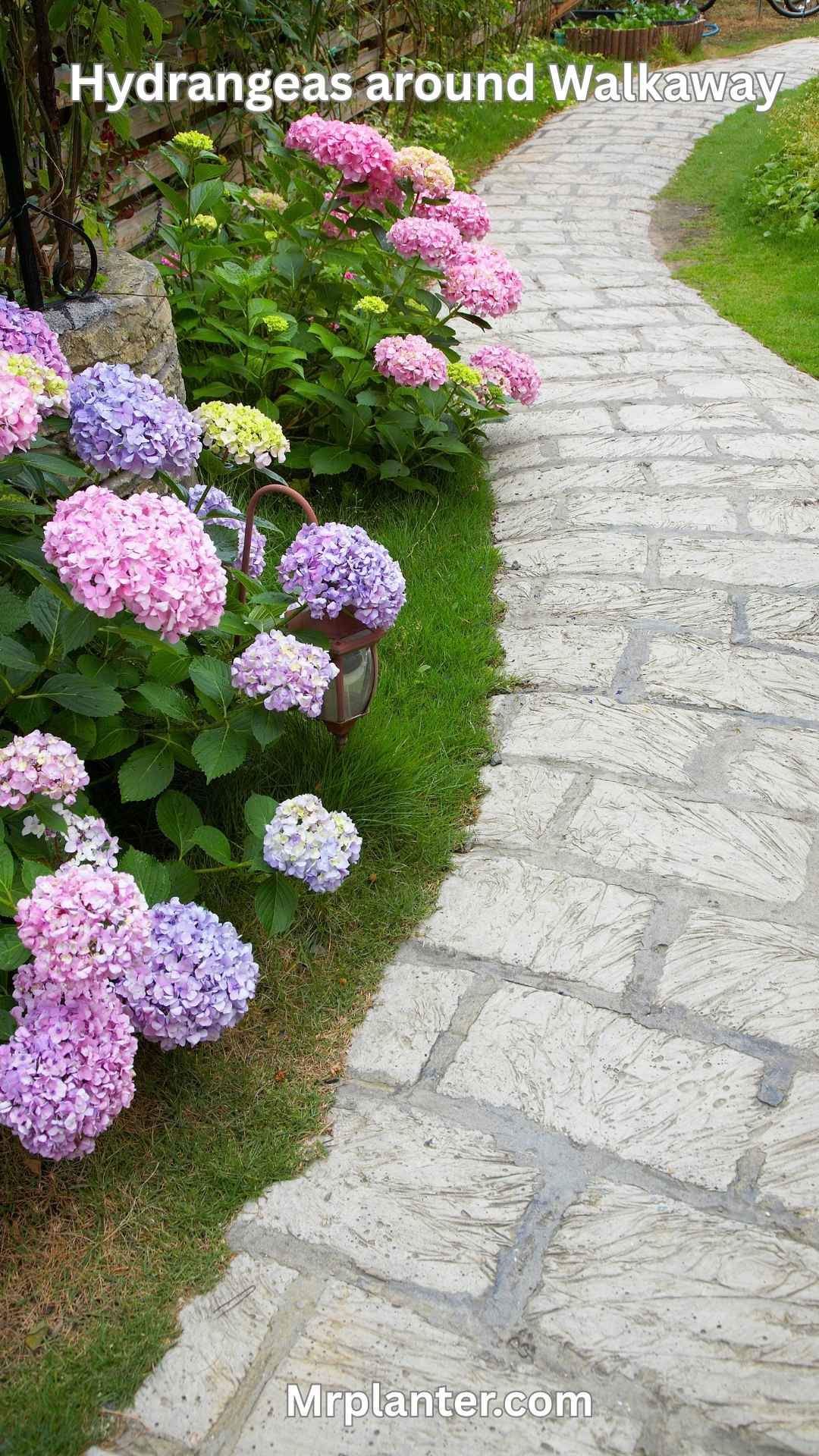
Planting hydrangeas along your garden walkway gives your path a bright, natural frame. Hydrangeas grow fast, and their big, colorful blooms make any walk more inviting.
Pick a few different hydrangea types if you want a mix of colors and shapes. That way, your border will have texture and stay interesting all season.
Space your plants out so they have room to fill in. Hydrangeas can hit about 4.5 feet tall, so don’t crowd them.
Choose a spot with morning sun and afternoon shade. Hydrangeas really prefer this kind of light.
Water them regularly, especially when it’s dry, so the flowers stay healthy. Mulching around the base keeps the soil moist and cuts down on weeds.
That way, you don’t have to fuss as much to keep things neat.
Expert Tip from MrPlanter: “Try planting hydrangeas in a gentle curve along your walkway for a softer look. If you mix up the heights, it adds depth and avoids that flat, straight-line feel.”
2. Plant blue hydrangeas for a cool-toned backyard vibe

Blue hydrangeas bring a calm, fresh look to your backyard. Their soft blue flowers can light up shady corners or garden borders.
If you want those vibrant blues, make sure your soil is acidic—below pH 6.5. Tossing in some aluminum sulfate helps keep the blue shade strong.
These plants like well-drained soil and a bit of shade. Too much sun can fade their color.
You don’t need to prune blue hydrangeas much, so they’re pretty easy to live with. They look great near patios or along driveways.
Try different types of blue hydrangeas to play around with shapes and shades.
Expert Tip from MrPlanter: “Check your soil’s pH before you plant. Mulch helps keep the soil moist and your hydrangeas happy.”
3. Use hydrangeas as a colorful privacy screen
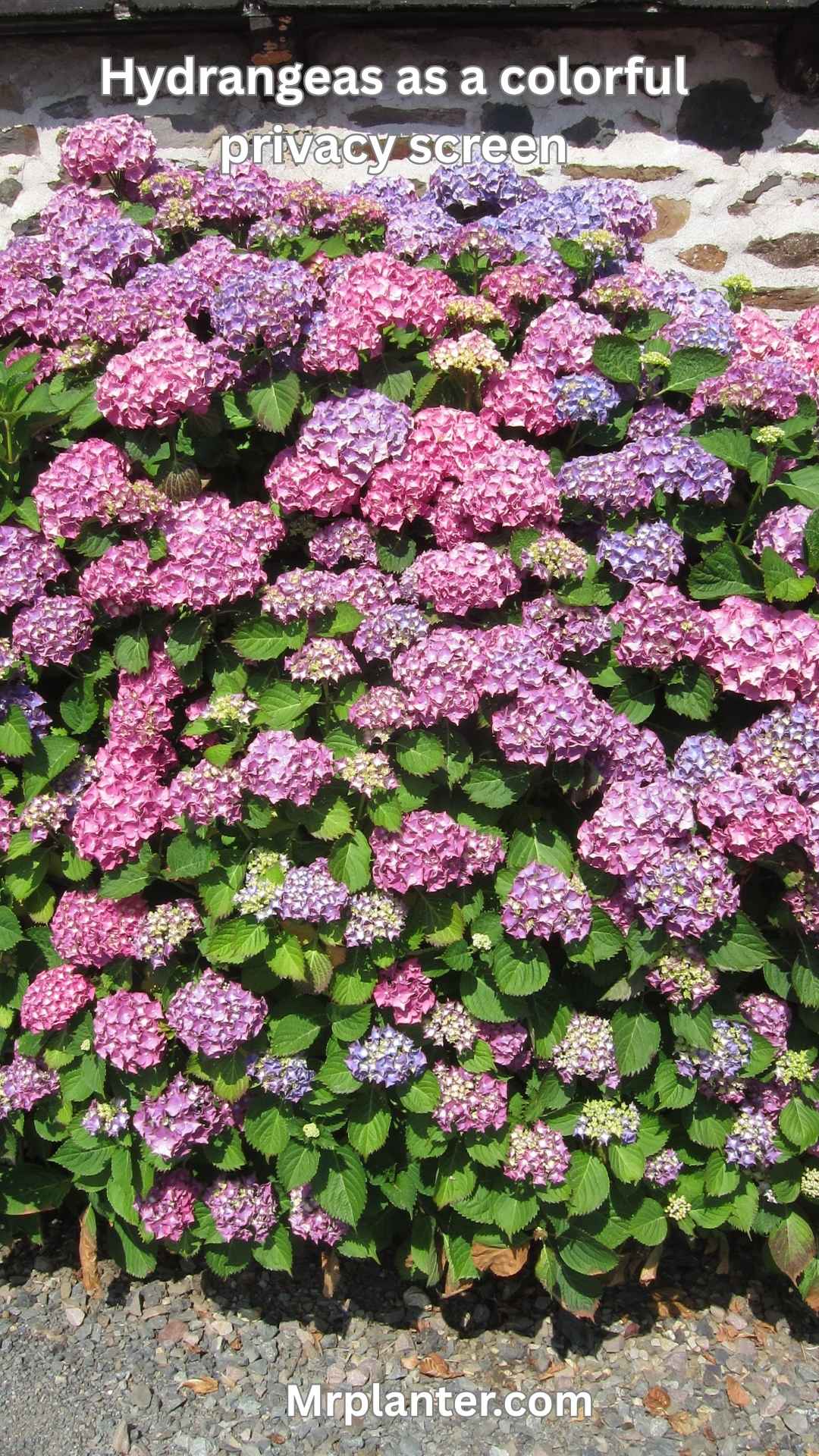
If you want a natural wall, plant hydrangeas close together. Their big leaves and blooms make a great screen and add a splash of color.
Hydrangeas work well along fences or property lines. Go for panicle or smooth hydrangeas if you want something taller.
These types can grow 6 to 10 feet high and offer plenty of coverage. Their flowers come in pink, blue, white, and purple.
You can tweak the color by changing the soil pH, so your privacy screen can look different every season. Water regularly and give them partial shade for best results.
Prune them each year to keep your screen dense and tidy. That way, you get privacy and a beautiful view.
Expert Tip from MrPlanter: “Plant hydrangeas in groups of three or more for a fuller screen. Mulch at the base to keep the roots cool and moist.”
4. Mix different hydrangea varieties for year-round interest

Mixing different hydrangea types keeps your backyard interesting through the year. Some bloom in summer, while others have pretty leaves or flowers in fall and winter.
Try bigleaf hydrangeas for bold summer color. Climbing or shrub hydrangeas can stay green longer.
Evergreen climbing hydrangeas add color and texture even in colder months. By mixing varieties, you get different shapes and sizes, which adds depth.
You can plan your garden so something is blooming or green when other plants fade. That way, your yard never feels empty.
Expert Tip from MrPlanter: “Choose hydrangeas with staggered bloom times. Pair rustic types with showy ones to keep your landscape interesting all year.”
5. Pair hydrangeas with hostas for shade-friendly spots
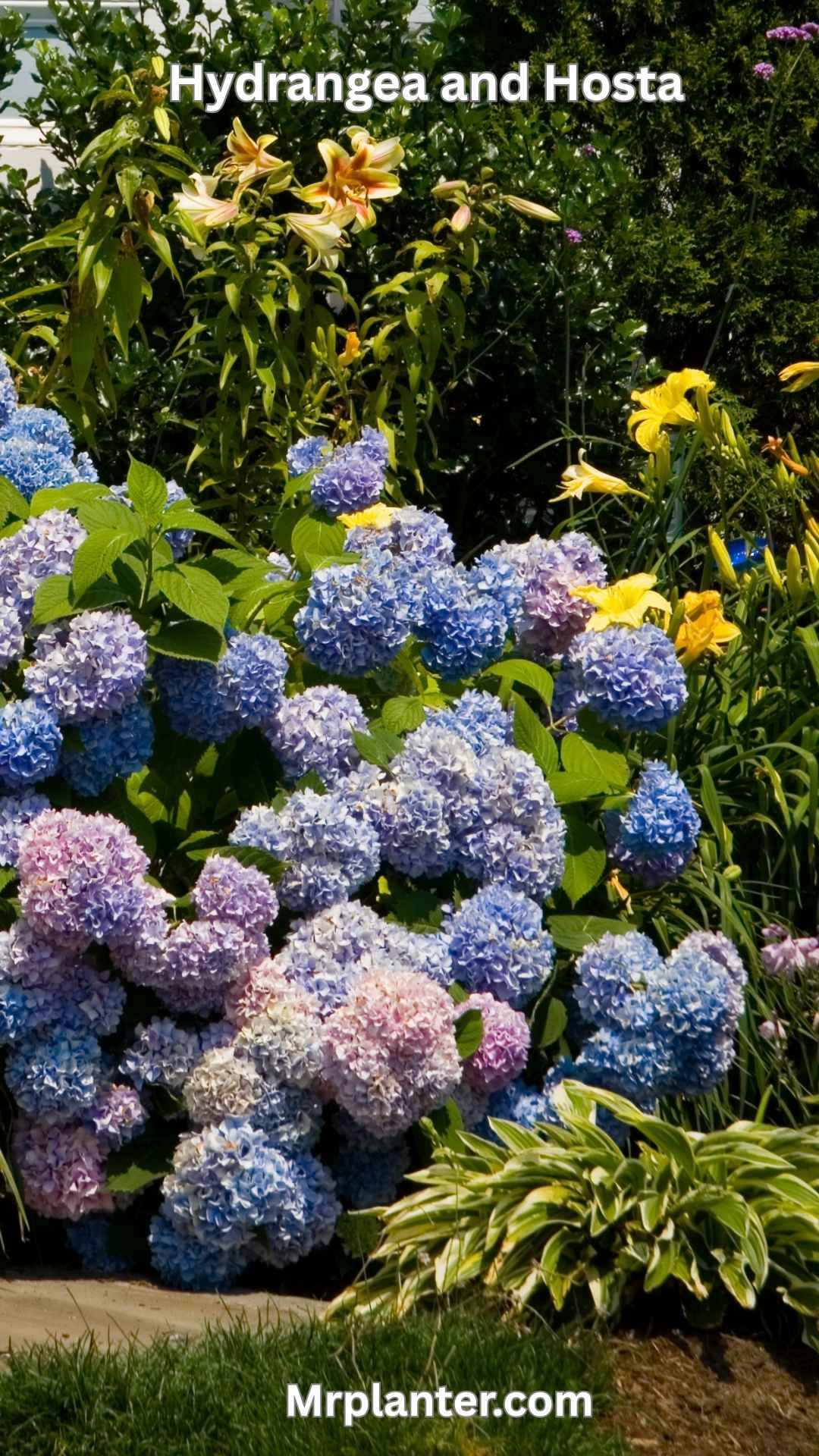
Hydrangeas and hostas really work well together in shady parts of your yard. Both like some shade, though hydrangeas need a bit of sun to bloom well.
Hostas can handle deeper shade and bring in big green or variegated leaves. When you plant them side by side, you get a lush, full look.
Hydrangea blooms look great next to hosta leaves. Both plants like moist, well-drained soil, so caring for them together is pretty simple.
Mix up different hydrangea and hosta types for more variety. Try white Annabelle hydrangeas with giant hostas for a soft, classic look.
Or use colorful hostas with blue hydrangeas for a nice contrast.
Expert Tip from MrPlanter: “Water your plants early in the day to avoid leaf damage. Mulch around them to keep the soil cool and moist.”
6. Add white hydrangeas near entryways for a fresh look
White hydrangeas make any entryway look clean and welcoming. Their bright blooms really pop and give your home a fresh feel.
These flowers do well in partly shaded spots, so they’re perfect near doors or walkways with some sun. They add elegance without being too much.
Planting white hydrangeas by your entryway can soften the look of steps or porch edges. They bring a natural charm that draws the eye but don’t crowd the space.
Pick a spot with good drainage to keep them healthy. Water them often during dry spells to keep their color bright.
Expert Tip from MrPlanter: “Put white hydrangeas where you can see them from inside. Their blooms will lift your mood every time you look out.”
7. Use pink hydrangeas to soften hardscape edges
Plant pink hydrangeas along patios, walkways, or stone walls to soften sharp lines. Their round blooms add a gentle touch to spaces that might feel too stiff.
Pink shades bring a warm, cheerful vibe that pairs nicely with concrete or brick. This helps your hardscape blend better with the rest of the garden.
Put hydrangeas where they get morning sun and some afternoon shade. This keeps the blooms healthy and bright.
Their size works well to fill gaps between pavers or along beds next to paths. Pair them with smaller plants for a layered look.
Hydrangeas can make great backdrops to highlight your hardscape without taking over. Their color shifts with soil pH, so you can play with different tones.
Expert Tip from MrPlanter: “Go for pink Bigleaf hydrangeas for the best color and fullness near edges. Keep the soil moist but well-drained for vibrant blooms.”
8. Plant mophead hydrangeas for big, dramatic blooms
If you want big, dramatic flowers, mophead hydrangeas are a solid pick. Their round flower clusters stand out and come in white, pink, or blue, depending on your soil’s pH.
Mopheads do best in partial to full sun but need some shade during the hottest part of the day. That helps avoid leaf damage.
Don’t prune them in winter or spring since they bloom on old wood. Wait until after flowering to give them a light trim.
Mophead hydrangeas grow fast and can be spaced closer than most shrubs. That makes them great for a lush hedge or border.
Try pairing them with perennials like daisies or peonies for a soft, inviting look. ‘Blushing Bride’ is a nice variety if you want blooms that start white and turn pink.
Expert Tip from MrPlanter: “Water mophead hydrangeas deeply once a week—more if it’s hot. Mulch to keep their roots cool and moist.”
9. Create a cottage garden feel with mixed hydrangeas and wildflowers
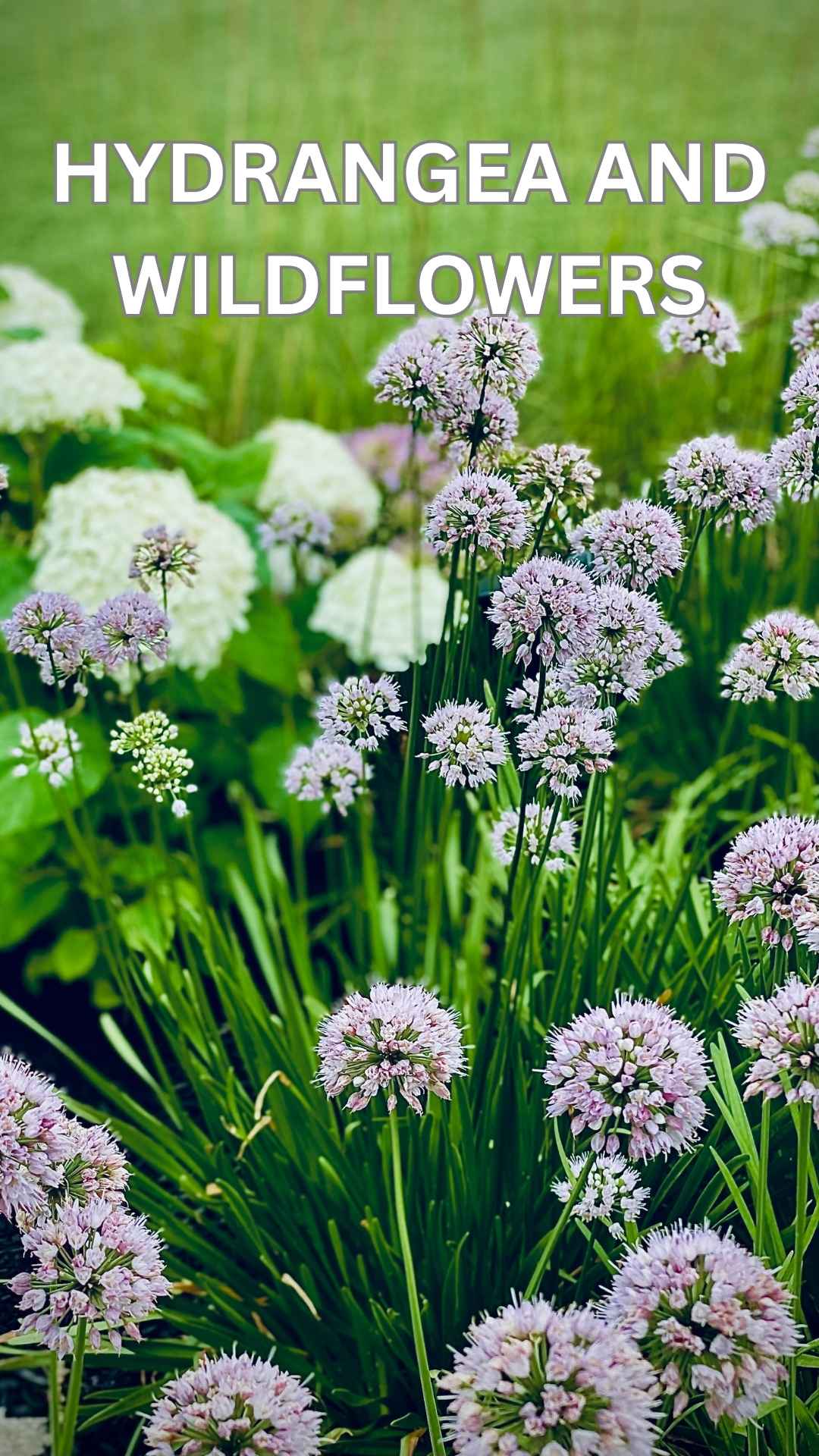
Mix hydrangeas and wildflowers to give your backyard a cozy, cottage vibe. Soft pink and lilac hydrangeas add gentle color, while wildflowers fill in the gaps and bring in butterflies and bees.
Plant hydrangeas near paths or seating areas for a sweet, inviting spot. Keep the planting informal for a relaxed, natural look.
Pick wildflowers that suit your climate and soil so they grow well with hydrangeas. Toss in a rustic path or a little wooden gate if you want to lean into that cottage feel.
Expert Tip from MrPlanter: “Mix up the hydrangea types for more bloom shapes and colors. Let wildflowers self-seed naturally for the best results.”
10. Use hydrangeas to frame your garden gate
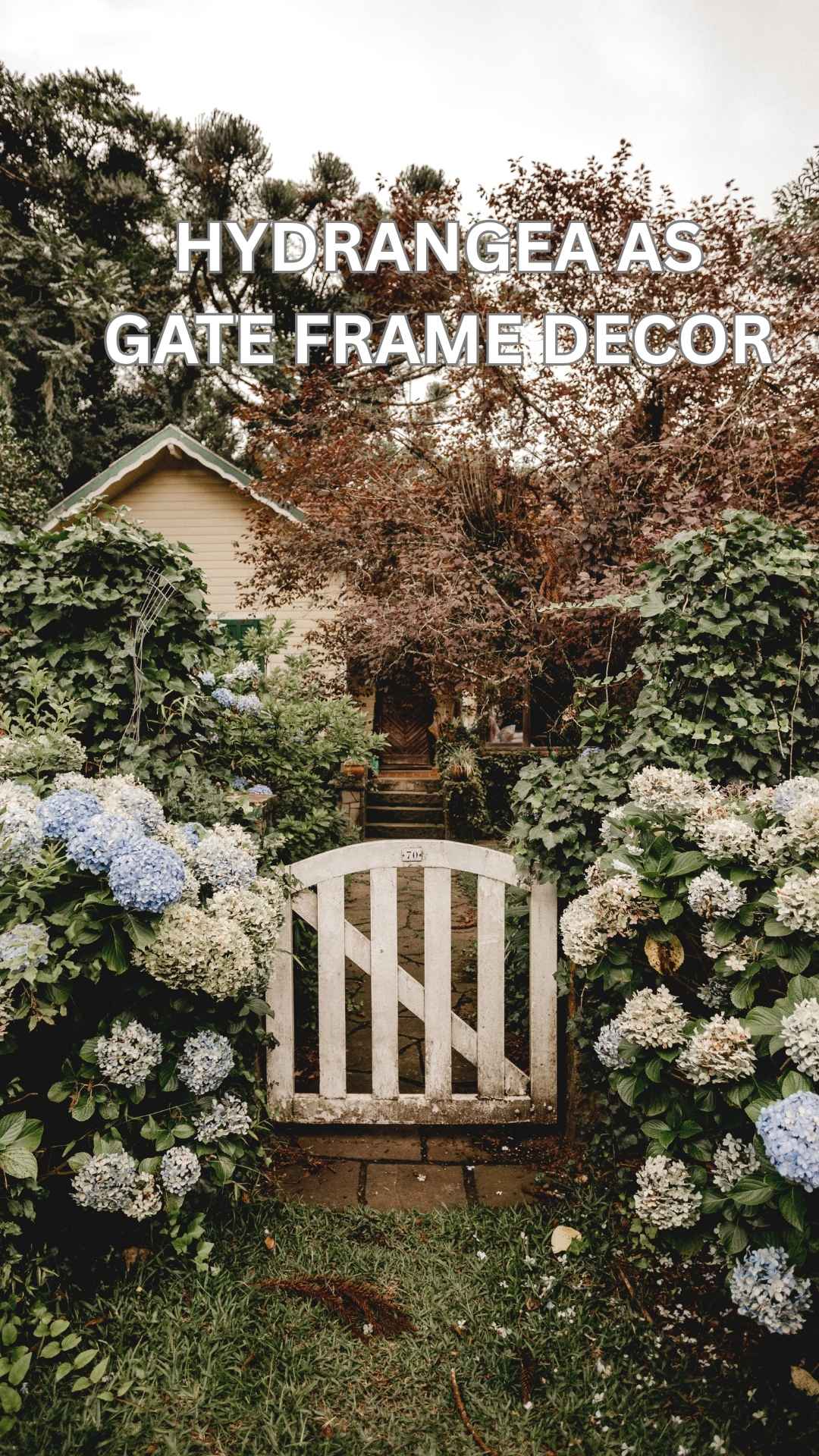
Framing your garden gate with hydrangeas creates a beautiful, welcoming entrance. Plant them on both sides to draw attention and add color.
Pick hydrangea varieties that fit your space. Larger bushes suit wide gates, while smaller types work for narrow spots.
Mix up the colors for a playful look. Keep the plants trimmed so they don’t block the path.
Water and mulch regularly to keep your hydrangeas healthy and blooming. Adding climbing plants nearby can soften the edges and give your entrance extra charm.
Expert Tip from MrPlanter: “Plant hydrangeas a little away from the gate posts to give them space. Mulch well to keep roots cool and moist in the summer.”
11. Plant lacecap hydrangeas for delicate, airy flowers
Lacecap hydrangeas show off a unique flower shape. Tiny fertile flowers cluster in the center, with a ring of bigger petals around them.
This creates a delicate, open look that’s hard to miss. If you want something light and airy, these hydrangeas fit right in.
They bloom during summer and can hang on into fall, bringing soft color for months at a time. Place them where they’ll catch morning sun but get some shade in the afternoon.
They really prefer well-drained soil that stays moist but not soggy. Lacecap hydrangeas come in several species, and lots of them can handle a range of climates.
Their flat flower heads give your backyard a vintage, elegant style that feels different from the usual round mophead types. If you water them regularly and shield them from harsh sun, they’re easy to care for.
The airy blooms attract pollinators too, which just makes your garden happier.
Expert Tip from MrPlanter: “Water lacecap hydrangeas deeply once a week to keep the soil moist. Prune them just after they bloom to promote healthy growth next season.”
12. Incorporate hydrangeas into container gardens on patios
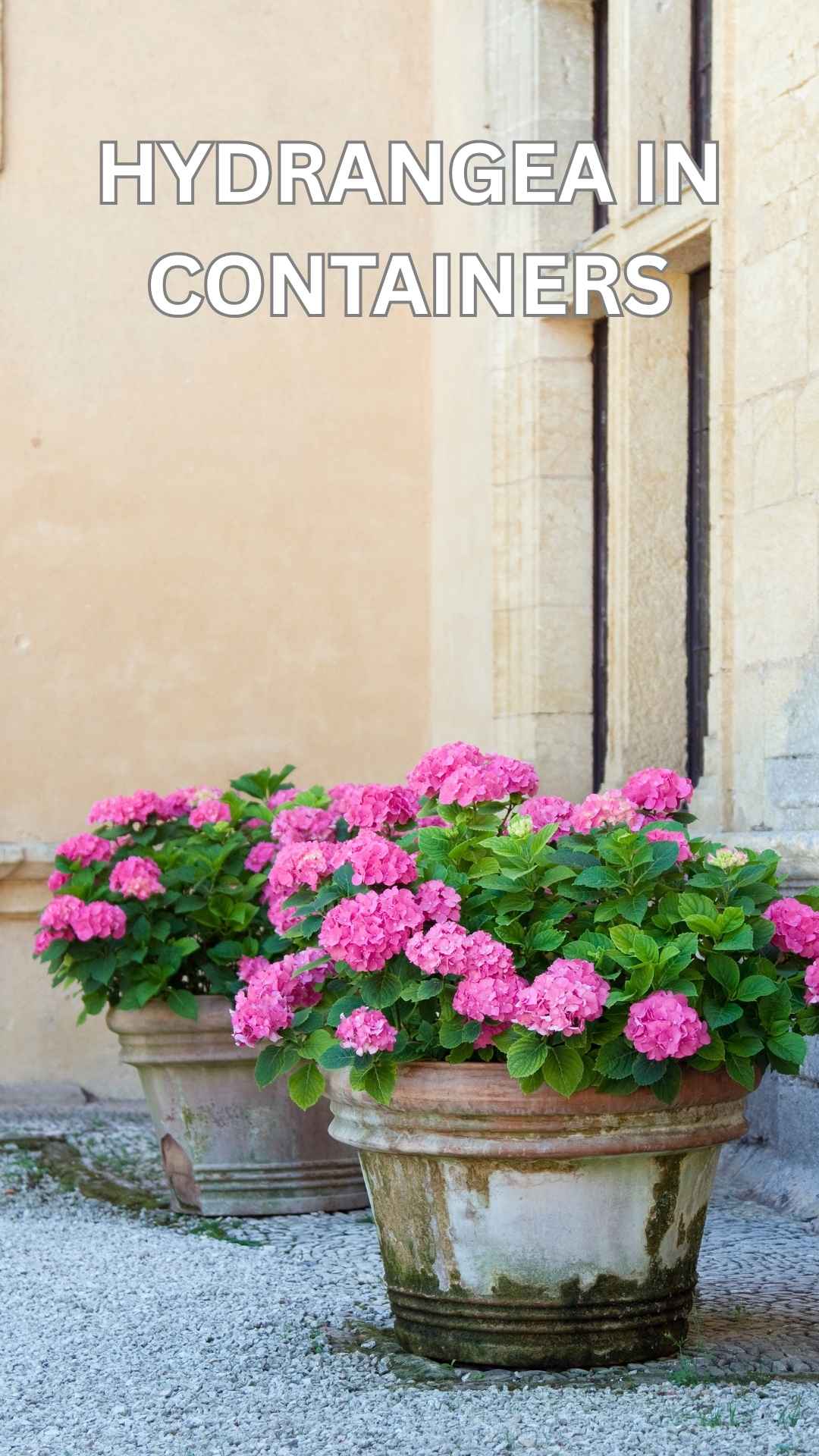
Hydrangeas in containers add a burst of color and life to your patio. You can move the pots around to chase the best light or switch up the look whenever you feel like it.
Pick containers with good drainage so roots stay healthy. Hydrangeas love steady moisture, but they hate sitting in water.
Bigleaf or smooth hydrangeas tend to do best in pots. They grow well and put on a solid show of blooms.
Set your hydrangea pots where they’ll catch morning sun and some afternoon shade. This keeps their leaves from burning and helps the flowers last.
Try mixing hydrangeas with shade-loving plants like ferns or hostas in the same container. That way, you get more texture and variety on your patio.
Use colorful or decorative pots to highlight the flowers and match your outdoor vibe. Swapping containers is an easy way to refresh the space.
Water your container hydrangeas often, especially when it gets hot outside. Feed them with balanced fertilizer during the growing season for the best blooms.
Expert Tip from MrPlanter: “Use mulch on top of the soil in pots to keep roots cool and moist. Check pot drainage holes often to avoid root rot.”
13. Combine hydrangeas with evergreens for winter structure
Hydrangeas steal the show in spring and summer, but once fall hits, they drop their leaves. Planting evergreens nearby helps your garden keep its shape and color through winter.
Boxwood or pine keep their green needles all year. They make a great backdrop, letting bare hydrangea branches stand out.
Plant hydrangeas in front of taller evergreens to build up some layers. This adds interest even when flowers are gone.
It also shields hydrangeas from cold winds, which is a nice bonus. Try mixing different textures—soft pine needles look great next to hydrangea leaves and blooms.
Winter interest matters if you want a garden you enjoy year-round. Evergreens give you that structure and keep things lively.
Expert Tip from MrPlanter: “Group your evergreens and hydrangeas in odd numbers to create a natural look. Prune evergreens lightly to keep hydrangeas visible through the winter.”
14. Add climbing hydrangeas on trellises or pergolas
Climbing hydrangeas thrive on trellises or pergolas. Their small roots latch on easily, so you don’t need a dense structure.
A simple frame with a few horizontal bars about 6 inches apart works just fine. Train the vines by loosely tying them with twine every 6 to 12 inches.
This keeps them growing where you want and looking neat. These plants do well in shade or partial shade, so they’re perfect for those tricky spots in your yard.
On pergolas, climbing hydrangeas bring a soft, leafy cover with clusters of white flowers. They’re great for privacy or hiding old fences.
Just remember, they grow slowly but fill out nicely as they mature.
Expert Tip from MrPlanter: “Choose a sturdy trellis that can support the plant’s weight as it grows heavier. Check ties regularly to avoid cutting into the vines.”
15. Plant hydrangeas along fences for vibrant borders
Hydrangeas along fences create a bright, colorful border that can really wake up your backyard. Tall blooms add height and texture, turning a plain fence into something special.
They work with wooden or metal fences, softening harsh lines and framing your yard naturally. Mixing different hydrangea varieties brings color changes through the season.
Make sure the fence area gets enough sunlight—most hydrangeas like partial shade. Water them regularly, especially when things get dry, to keep the soil moist but not soggy.
Add mulch at the base to help hold moisture and keep weeds down. Trim off dead or old flowers for a tidier, healthier look.
Plant hydrangeas close enough to cover the fence but leave a bit of space for air to move. This helps keep disease away and lets the plants breathe.
Expert Tip from MrPlanter: “Choose varieties with different bloom times to keep your fence colorful all season. Don’t forget to test your soil pH – it can change flower colors on some hydrangeas.”
16. Use variegated leaf hydrangeas for extra foliage interest
Variegated leaf hydrangeas have leaves edged with white, cream, or sometimes even pink. These patterns add color and texture, even when flowers aren’t in bloom.
They stand out next to solid green plants and look great in a mix of hydrangea types. Try placing them near pathways or entrances to catch the eye.
Their unique leaves give your backyard a fresh, layered look. Variegated hydrangeas also work well in shady spots.
Their bright leaves help lighten up darker corners of your garden. This keeps the space interesting all year.
Expert Tip from MrPlanter: “Plant variegated hydrangeas where their leaf patterns catch light for the best effect. Pair them with darker foliage to make the colors pop.”
17. Design a hydrangea hedge for informal backyard fencing
Hydrangeas make a soft, natural hedge that adds color and charm. Line your backyard borders with these plants for a floral barrier that feels welcoming, not harsh.
Hydrangea hedges help mark paths or separate garden areas without blocking the view. Their flower clusters give a full, lush look that changes through the seasons.
Choose varieties that fit your climate and space. Prune them regularly to keep the hedge neat but let the flowers shine.
Plant hydrangeas close enough for a solid line but leave room for growth. This hedge style blends structure with a relaxed, cottage garden vibe.
It also attracts pollinators like bees and butterflies, which is always good news for your garden.
Expert Tip from MrPlanter: “Water new hedges regularly to help roots establish. Prune right after flowering to keep plants healthy and encourage more blooms.”
18. Mix hydrangeas with ornamental grasses for texture contrast
Pair hydrangeas with ornamental grasses to add texture to your garden. The soft, feathery grass blades play off the big, round hydrangea blooms.
Ornamental grasses sway in the breeze, bringing gentle motion near the steady flowers. It makes your backyard feel more dynamic and balanced.
Pick grasses that like similar conditions—moist soil and some shade. Japanese sedge works well since it stays low and has cool striped leaves.
This combo fits lots of garden styles, from wild to tidy. It breaks up color blocks with different heights and shapes.
Expert Tip from MrPlanter: “Pick grasses that don’t grow taller than your hydrangeas, so neither overshadows the other. Keep the planting spots slightly moist to help both thrive side by side.”
19. Use panicle hydrangeas for their long blooming season
Panicle hydrangeas bloom from summer into fall, sometimes even longer. Their flowers start out white or green, then slowly turn pink or red as the season passes.
This keeps your garden colorful for months. These hydrangeas are pretty tough and handle cold weather easily.
They need less care than other types, which is always a plus. You can find dwarf varieties for small spaces or go for bigger ones that make more of a splash.
Since their blooms last so long, panicle hydrangeas work well as focal points or along garden paths. They bring steady color without much fuss.
Expert Tip from MrPlanter: “Plant panicle hydrangeas where they get full sun for the best blooms. Prune them in late winter to keep them healthy and encourage more flowers.”
20. Create a shaded retreat spot surrounded by hydrangeas
Pick a quiet corner in your backyard that gets some shade. Hydrangeas love these spots and will add lush color all around.
Plant them close together so they form a natural screen. That makes your retreat feel private and cozy.
Add a comfy bench or chair in the middle. Suddenly, you’ve got a peaceful spot to relax and enjoy the blooms.
Mix hydrangeas with different flower colors to brighten things up. Blues, pinks, and whites set a calm, pretty tone.
Water your plants regularly, especially during dry spells. Healthy hydrangeas will keep your retreat looking fresh and inviting.
Trim the bushes lightly after they bloom to keep the shape neat. That makes the space feel tidy and cared for.
Expert Tip from MrPlanter: “Choose a spot that gets partial shade to keep your hydrangeas healthy and vibrant. Regular watering is key to making your shaded retreat flourish.”
21. Place hydrangeas near water features for reflection beauty
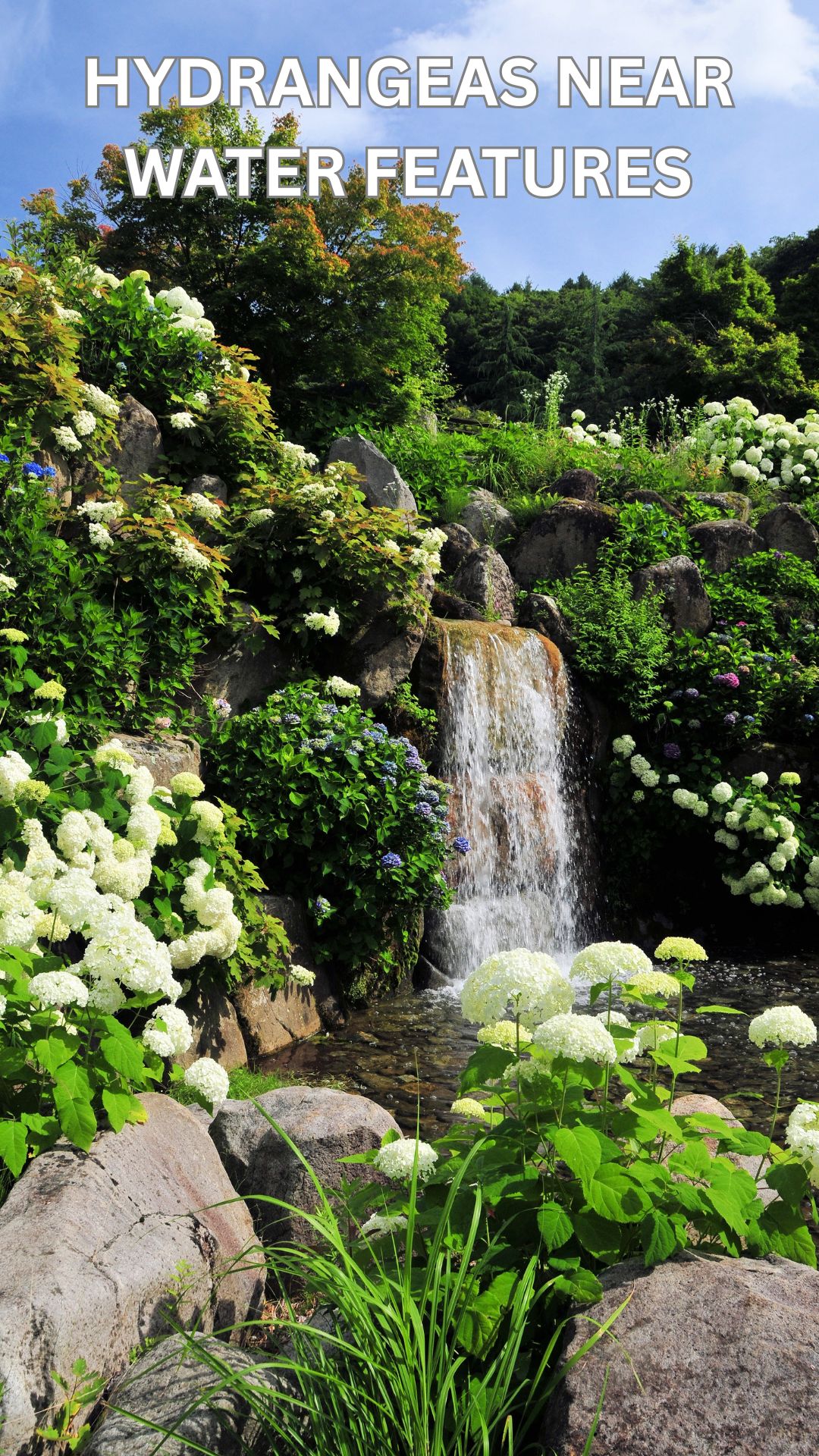
Put hydrangeas near water features like ponds or fountains for a calm, pretty effect. The flowers reflect on the water, doubling the color and making the scene more peaceful.
Hydrangeas enjoy moist soil, so planting them close to water keeps them happy. The extra humidity helps the blooms stay fresh a bit longer.
You can surround a small pond with hydrangeas to create a relaxing spot. Their leafy greens and colorful flowers blend in with the water’s movement.
Keep the soil damp, but don’t let it get soggy—too much water can hurt the roots. Water regularly, especially if your water feature doesn’t add much moisture to the soil.
Expert Tip from MrPlanter: “Choose hydrangeas with soft colors to enhance the water’s reflection. Water them early in the morning to keep soil moist without overwatering.”
22. Use pastel hydrangea colors for a soft garden palette

Pastel hydrangeas show off gentle shades like soft pink, light blue, and creamy white. These colors bring a calm, peaceful vibe to your backyard.
They mix in easily with other plants and somehow make the whole garden feel more inviting. I’ve found they work especially well near patios or seating areas, where you want just a quiet touch of color.
You can also tuck pastel hydrangeas into shaded corners, where bold colors might feel too harsh. When you pair these soft blooms with plenty of green foliage, the garden looks fresh and balanced.
If you’re after a classic, elegant style, pastels really do the trick.
Expert Tip from MrPlanter: “Plant pastel hydrangeas in well-drained soil and partial sun for the best color. Water them regularly but avoid soggy soil to keep blooms healthy.”
23. Mix hydrangeas with roses for romantic vibes

Try pairing hydrangeas with roses if you want a charming touch in your backyard. Those blooms together can create a mix of soft and bold colors that just feels right.
Roses love full sun, but hydrangeas lean toward a bit of shade. You’ll want to find a spot where both can get what they need—honestly, it takes some trial and error.
Keep the soil rich and moist, but don’t let it get soggy. Good drainage helps everything stay happy.
Pick rose and hydrangea varieties that actually fit your space. I find that smaller roses look great with medium-sized hydrangeas, so nothing feels too crowded.
Water them regularly—about 1 to 2 inches each week should do the trick. They’ll reward you with healthy growth.
This combo even brings more pollinators, which is a win for your whole garden.
Expert Tip from MrPlanter: “Plant hydrangeas where they get morning sun and afternoon shade. Make sure roses have at least six hours of sun daily for the best blooms.”

